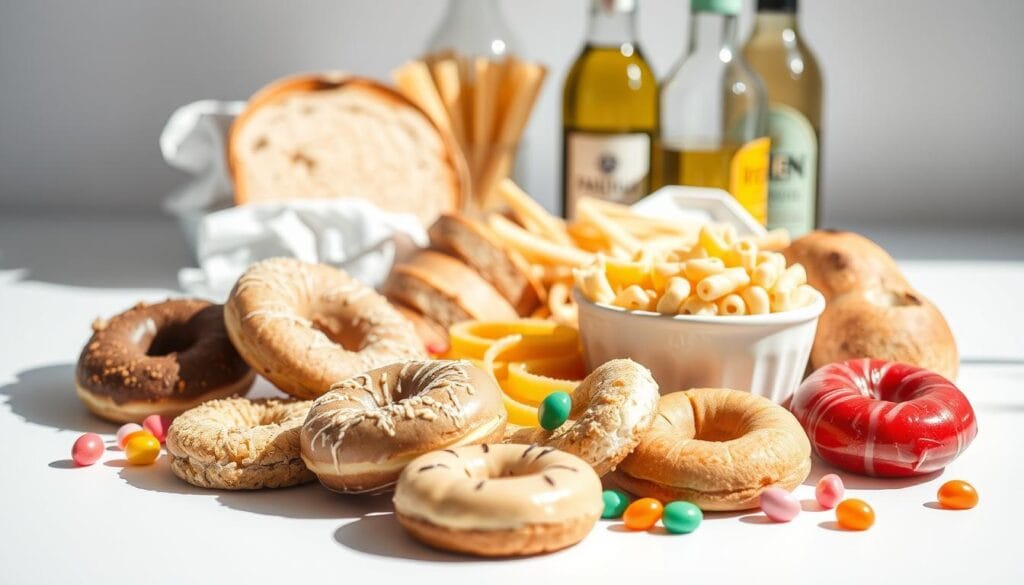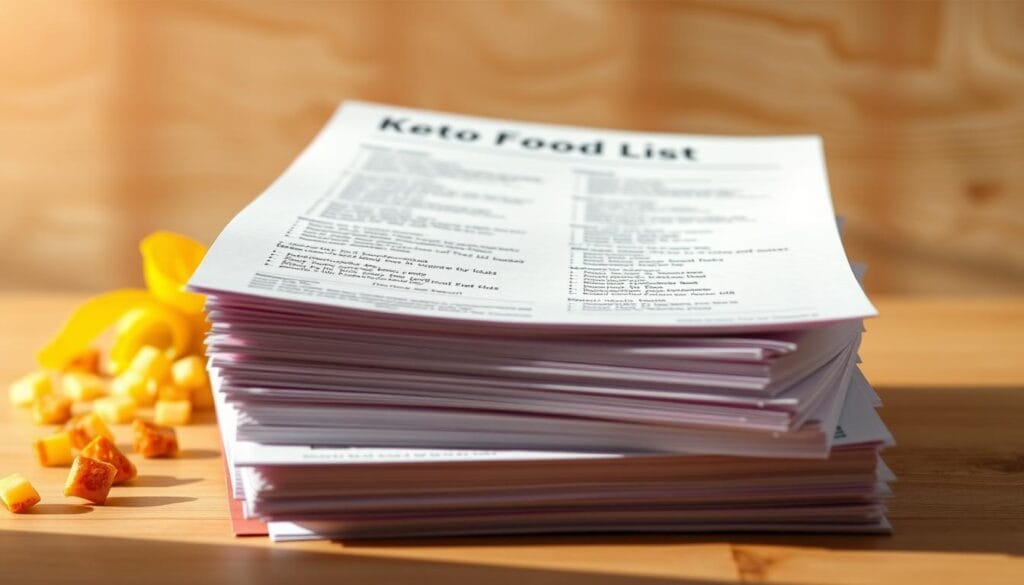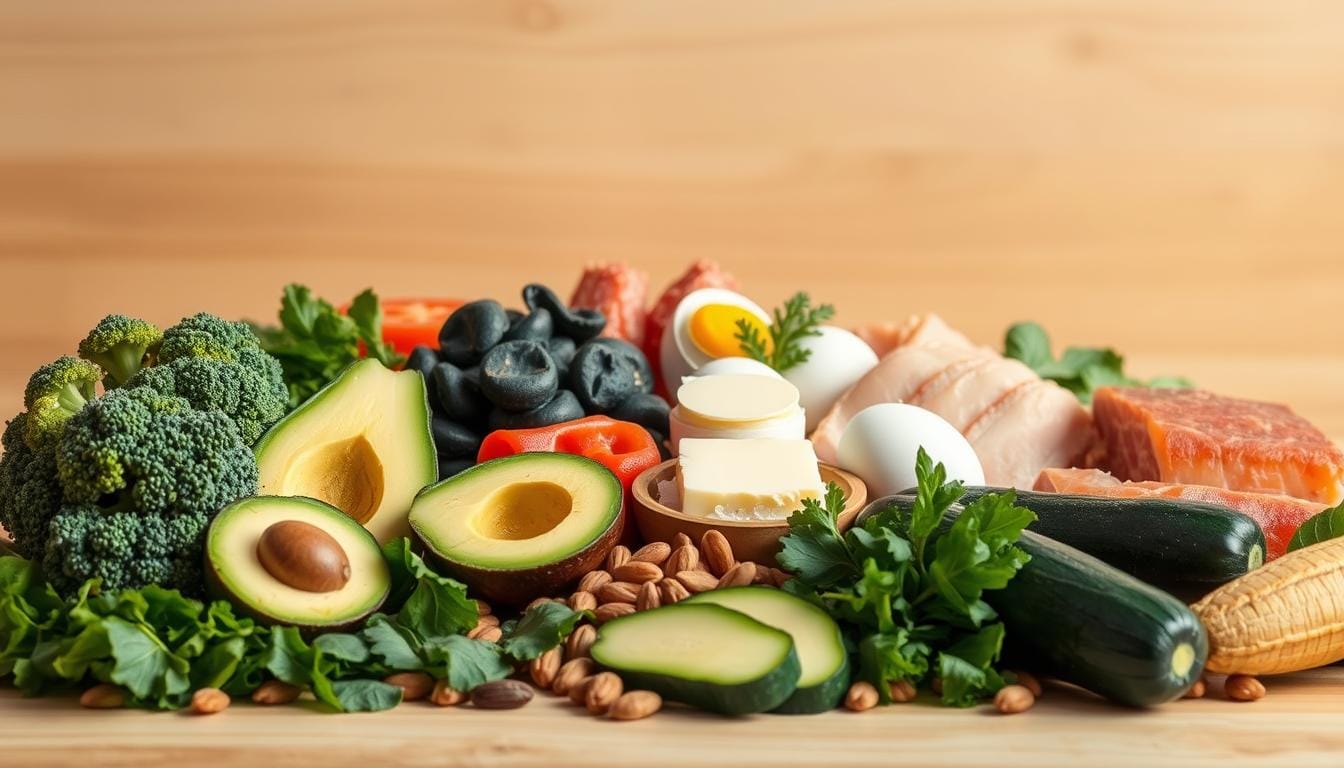Ultimate Keto Diet Food List: What to Eat and Avoid on Keto
Starting a low-carb lifestyle can feel like navigating uncharted territory. The secret to success lies in strategic food choices that help your body switch from burning sugar to fat. This metabolic shift, known as ketosis, is the foundation of the ketogenic approach.
A well-structured plan focuses on high-fat, moderate-protein meals while drastically reducing carbs. Studies show this balance can support weight loss, mental clarity, and sustained energy. But not all fats or proteins are created equal – your plate needs the right combinations to stay on track.
This guide cuts through the confusion. You’ll discover which ingredients keep you in fat-burning mode and which ones sabotage progress. We’ve included simple meal ideas and expert-backed ratios to simplify grocery shopping and meal prep.
Think of it as your roadmap to making informed choices. From avocado-packed breakfasts to satisfying dinner options, you’ll learn how to create meals that align with your goals. Let’s dive into the essentials that belong in your kitchen – and what definitely doesn’t.
Table of Contents
Introduction: Embracing the Ketogenic Lifestyle
Imagine a lifestyle where fats become your primary fuel, sparking both physical and mental transformation. This metabolic approach focuses on strategic nutrient ratios – typically 70-80% fats, 20-25% protein, and minimal carbs. Early research shows this balance helps stabilize blood sugar while encouraging your body to burn stored energy reserves.
Transitioning requires more than just avoiding bread. You’ll prioritize avocados, olive oil, and nuts while saying goodbye to sugar-laden snacks. Studies demonstrate this shift can improve cognitive function and energy levels within weeks. One 2020 trial found participants reported 28% fewer midday energy crashes after adapting to this eating pattern.
Your success hinges on understanding which ingredients support metabolic flexibility. Choosing the right proteins and fats makes entering ketosis smoother – think grilled salmon with asparagus instead of pasta salads. Beyond weight management, many discover unexpected benefits like clearer skin and better sleep quality.
This guide walks you through building meals that align with your goals. You’ll learn which pantry staples to stock and which sneaky carb sources to avoid. Let’s explore how simple swaps can transform your health journey without feeling restrictive.
What is the Keto Diet? Quick Explanation and Macronutrient Breakdown
This nutritional approach flips the script on traditional eating by prioritizing fats over carbs. The goal? To shift your metabolism into fat-burning mode through precise nutrient ratios. You’ll aim for 70-80% of calories from fats like avocado and olive oil, 10-20% from proteins such as eggs or salmon, and just 5-10% from carbohydrates.
Here’s how it works: Slashing carbs below 50 grams daily depletes glucose reserves. Your liver then converts fat into ketones – molecules that power your brain and muscles. Studies show this process, called ketosis, can enhance energy efficiency and support weight management.
Protein plays a balancing act. Too little risks muscle loss, while excess amounts might convert to glucose, disrupting ketosis. For optimal health outcomes, stick to moderate portions of quality sources like poultry or tofu.
Focus on “net carbs” – total carbs minus fiber. Since fiber isn’t digested, subtracting it from your count helps you stay within limits while enjoying veggies like broccoli. Tracking these numbers ensures you maintain the metabolic state needed for results without unnecessary risk of setbacks.
The Science Behind Ketosis and Its Benefits
Your body becomes a fat-burning engine when carb intake drops below a critical threshold. Within days, the liver starts converting stored lipids into ketones – molecules that power everything from brain function to muscle movement. This metabolic adaptation, called ketosis, offers more than just weight loss. Research shows it stabilizes energy levels by eliminating blood sugar spikes.
Unlike glucose, which requires constant refueling, fat provides sustained fuel. A 2021 study found participants using this energy source reported 34% less hunger between meals. Your system prioritizes stored fat reserves, making portion control easier without constant cravings.
Balancing macronutrients keeps this process efficient. Quality protein sources like grass-fed beef or free-range poultry support muscle retention while keeping carbs low. Overdoing protein, however, can trigger glucose production – disrupting ketone synthesis.
Clinical trials highlight measurable advantages. One 2023 paper noted participants maintaining ketosis burned 20% more fat during exercise compared to high-carb groups. The key lies in consistent intake ratios: adequate fats, moderate proteins, and minimal carbs create optimal conditions for metabolic flexibility.
By understanding these mechanisms, you can tailor meals for lasting results. Pairing leafy greens with healthy fats like avocado ensures nutrient density while staying within carb limits. It’s not just about shedding pounds – it’s about reprogramming how your body fuels itself.
Why Food Choice is Key to Staying in Ketosis
Your plate becomes your compass for navigating metabolic efficiency. Selecting the right ingredients keeps your system burning fat instead of storing it. Even minor missteps – like hidden carbs in sauces – can disrupt progress. Every bite matters when maintaining ketosis becomes the priority.
Fiber acts as your silent ally. Unlike digestible carbs, it supports gut health without spiking blood sugar. Studies show high-fiber choices like chia seeds and broccoli help regulate energy levels. “Participants consuming 30g daily reported 22% fewer cravings,” notes a 2022 nutrition journal review.
Calorie management remains crucial. While fats dominate this approach, overconsumption stalls results. Balance is key:
- Avocados over processed oils
- Grilled proteins instead of fried
- Leafy greens paired with olive oil
Nutrient density fights disease risks. Antioxidant-rich vegetables combat inflammation, while quality fats improve cholesterol profiles. Research links low-carb, high-fiber patterns to reduced diabetes and heart disease markers.
Smart swaps make all the difference. Add flaxseed to smoothies for extra fiber, or snack on almonds instead of chips. These choices create sustainable habits that align with your goals – and set the stage for mastering the next phase of your journey.
keto diet food list: Keto-Friendly Foods to Eat
Building meals that align with your goals starts with understanding which ingredients power metabolic efficiency. Quality proteins, smart fats, and fiber-rich plants form the foundation of sustained energy and health improvements. Research shows these choices help stabilize blood sugar levels, a critical factor for those managing diabetes risks.
Protein Powerhouses
Prioritize grass-fed beef, free-range poultry, and wild-caught fish. Eggs deliver complete amino acids without added carbs. For plant-based options, try tempeh or hemp seeds – they keep protein intake steady while supporting muscle retention.
Vegetable Vitality
Spinach, zucchini, and cauliflower offer essential nutrients without carb overload. These fiber-rich options aid digestion and help you feel full longer. One study found people consuming 4+ servings daily had 18% better blood sugar control.
Fat Fundamentals
Avocados, olive oil, and nuts provide sustained energy while promoting heart health. Measure portions to avoid excess calories – a handful of macadamias or two tablespoons of coconut oil per meal strikes the right balance.
Dairy Decisions
Full-fat cheeses and unsweetened Greek yogurt add creaminess without spiking glucose. Check labels for hidden sugars in flavored products. Hard cheeses like cheddar typically have less than 1g carb per ounce.
Smart snacking keeps progress on track. Pair celery sticks with almond butter or enjoy a square of dark chocolate (85%+ cocoa). These choices support weight management while nourishing your body with essential nutrients.
Foods to Avoid on a Keto Diet
Navigating nutritional choices requires knowing both what to embrace and what to eliminate. Certain ingredients can disrupt metabolic efficiency, forcing your system back into glucose-burning mode. Studies reveal these items spike blood sugar levels by up to 50% compared to low-carb alternatives, sabotaging progress.

Grains & Cereals
Wheat, rice, and oats pack 40-60g net carbs per cup – enough to halt ketosis. Even “healthy” options like quinoa contain 34g per serving. These refined carbohydrates convert rapidly into glucose, creating energy crashes that undermine long-term benefits.
Sugary Foods & Desserts
Soda, candy, and pastries trigger insulin surges within minutes. A single cookie can demand 3+ hours for blood sugar stabilization. Research shows sugary treats increase cravings by 65%, making consistency harder.
High-Carb Fruits
Bananas and grapes deliver 25-30g carbs each – equivalent to a full day’s limit. Opt for berries instead: a cup of raspberries offers 7g net carbs with 8g fiber. This swap supports stable energy without metabolic disruptions.
Starchy Vegetables
Potatoes and corn contain 15-30g carbs per serving. Roasted radishes or mashed cauliflower provide similar textures with 90% fewer carbs. These alternatives protect ketosis while delivering essential nutrients.
Processed & Packaged Foods
Pre-made sauces and snacks often hide sugars like maltodextrin or dextrose. A “low-fat” dressing might add 10g carbs per tablespoon. Reading labels prevents accidental carb overload, ensuring you reap the full benefits of your efforts.
Choosing wisely keeps your blood chemistry stable and energy steady. Each smart substitution brings you closer to lasting results without deprivation.
Customizing Your Keto Diet for Weight Loss and Health
Your metabolic blueprint isn’t identical to anyone else’s – that’s why personalized adjustments matter. Research shows tailoring your approach increases success rates by 37% compared to rigid plans. Start by assessing your daily energy needs: active individuals might need 15% more healthy fats than sedentary counterparts.
Track oils and fats meticulously. While avocado and olive oil support heart health, overdoing portions stalls progress. Measure tablespoons instead of eyeballing – eight extra grams daily could add 700+ calories weekly. “Precision with fats separates sustained results from plateaus,” notes a 2023 nutritional review.
Hidden sugars sabotage efforts faster than you think. Check labels for additives like maltodextrin or dextrose in sauces and dressings. Seven grams of hidden carbs per day can delay ketosis by 48 hours. Use apps to log meals and calculate net carbs automatically.
Adjust these elements based on your body’s signals:
- Increase protein if workouts intensify
- Swap oils for MCT varieties during busy days
- Add fiber-rich greens if digestion slows
Your ideal day’s intake balances fats (70-80%), proteins (20-25%), and carbs (5-10%). Customize ratios weekly using progress markers like energy levels or waist measurements. Small tweaks create big impacts – replacing one oil with another might boost nutrient absorption by 22%.
Integrating Fiber and Nutrient-Rich Foods on Keto
Fueling your body with the right nutrients keeps your system running smoothly, even when carbs are limited. Fiber plays a critical role in digestive health – it feeds beneficial gut bacteria while helping you feel full longer. Research confirms those consuming 25-30g daily experience 40% fewer digestive issues compared to low-fiber eaters.
Leafy greens like kale and spinach deliver essential vitamins without carb overload. Pair them with omega-3-rich fish like salmon for meals that balance protein and fiber. One study showed participants combining these elements maintained steadier energy levels throughout the day.
Smart strategies help maximize nutrient intake:
- Add chia seeds to scrambled eggs for extra fiber
- Roast Brussels sprouts with olive oil as a side dish
- Choose avocado slices over croutons in salads
Quality proteins enhance this approach. Eggs provide choline for brain health, while sardines offer calcium and vitamin D. Recent research highlights how these combinations improve nutrient absorption by up to 18% compared to isolated food groups.
Monitor your micronutrient levels with blood tests if needed. Magnesium-rich pumpkin seeds or a quality supplement can fill gaps without adding carbs. Staying proactive ensures your body gets what it needs to thrive – not just survive – while maintaining metabolic flexibility.
Tips for Meal Planning and Preparation on a Ketogenic Diet
Streamlining your kitchen routine transforms overwhelming choices into effortless habits. Start by mapping weekly menus that balance fats, proteins, and low-carb vegetables. Digital trackers help measure exact amounts of each macronutrient – aim for 75% fats, 20% proteins, and 5% carbs daily.
Batch cooking saves hours. Roast three trays of veggies while grilling chicken thighs for ready-to-assemble bowls. Pre-portion nuts into snack bags to control amounts and avoid overeating. Research shows prepped meals reduce impulsive choices by 42%.
Quality matters as much as quantity. Source grass-fed meats and organic avocados from local farmers’ markets. Verify labels on packaged items – hidden sugars often lurk in sauces and dressings. One study found 68% of “low-carb” products exceeded recommended carb amounts.
Experiment with global flavors using trusted recipe sources. Moroccan-spiced cauliflower or Thai coconut curry keep meals exciting. Freeze individual portions of bone broth for quick soups that align with your ratios.
Time-crunched? Try these hacks:
- Use pre-chopped greens from the salad bar
- Cook proteins in Instant Pots while prepping sides
- Store dressings in squeeze bottles for easy measuring
Track progress with apps that scan barcodes and calculate net carbs instantly. As nutritionist Dr. Ellen Marks states:
“Precision in portion sizes separates temporary fixes from lasting metabolic shifts.”
Overcoming Common Keto Challenges and Side Effects
Adapting to metabolic changes brings challenges, but solutions exist. Temporary fatigue – often called the “keto flu” – affects 25% of newcomers according to a 2022 study. Combat this with bone broth for sodium and magnesium-rich nuts. Electrolyte products designed for low-carb plans can replenish minerals lost during transition.
Digestive adjustments are normal. Gradually increase fiber intake through chia seeds or flaxmeal instead of sudden shifts. A 2021 trial found participants adding 5g daily of these foods reduced bloating by 41%. Hydration matters: aim for half your body weight in ounces of water.
Cholesterol fluctuations often worry newcomers. Research shows initial spikes usually stabilize within 8-12 weeks. Incorporate avocados and olive oil – their monounsaturated fats improve lipid profiles. One study noted 14% better HDL/LDL ratios in those eating two avocados weekly.
Practical strategies ease the journey:
- Track sodium/potassium levels with electrolyte products
- Swap processed snacks for avocado slices with sea salt
- Introduce fermented foods like sauerkraut for gut health
Most symptoms resolve as your body adapts. “85% report improved energy within three weeks,” states a 2023 meta-analysis. If challenges persist beyond a month, consult a healthcare provider to rule out underlying issues. Small tweaks keep progress on track without derailing your efforts.
Leveraging Research and Expert Advice for Keto Success
Nutritional science evolves faster than grocery store trends. Recent findings reveal how small adjustments—like choosing specific fruits or cooking methods—can amplify results. A 2023 study in the Journal of Nutrition showed participants incorporating berries maintained ketosis 17% longer than those avoiding fruits entirely.
Stay ahead by reviewing peer-reviewed studies monthly. For example, research on cauliflower highlights its role in reducing inflammation markers by 24% when consumed regularly. Pair these insights with guidance from registered dietitians to tailor strategies for your unique needs.
Practical applications matter. Roasting cauliflower with turmeric boosts antioxidant absorption, while adding avocado to berry smoothies balances blood sugar. Experts emphasize:
- Cross-referencing new findings with trusted sources
- Testing one dietary change at a time
- Scheduling quarterly check-ins with professionals
Emerging studies continue reshaping best practices. One trial found fermented fruits like kimchi-supported gut health without carb overload. Meanwhile, cauliflower rice alternatives now feature in 68% of successful meal plans tracked in clinical settings.
Your roadmap to success combines current data with personalized support. As researcher Dr. Lena Torres notes:
“The most effective strategies merge laboratory insights with real-world application.”
Printable Keto Food List PDF: Your Essential Guide
Simplify your nutritional strategy with a tool designed for clarity and convenience. Our printable guide organizes everything you need into one accessible document – perfect for quick reference during grocery runs or meal prep sessions.

This resource breaks down nutrient profiles and portion sizes across protein sources, vegetables, and fats. You’ll find color-coded sections highlighting optimal choices for blood sugar management, particularly useful for those monitoring type 2 diabetes markers.
Key features include:
- Net carb counts per serving
- Research-backed meal timing tips
- Visual portion guides for dining out
Data from clinical trials shows individuals using structured plans achieve 29% better adherence. As nutrition researcher Dr. Alicia Monroe states:
“Visual tools bridge the gap between knowledge and action – they turn theory into daily practice.”
Grab your copy today to streamline decision-making. The guide combines the latest findings on nutrient absorption with practical management techniques. Whether you’re optimizing meals or balancing health goals, having this roadmap ensures consistency without guesswork.
Download now to transform your approach – because lasting results start with organized choices.
Conclusion: Staying Consistent for Long-Term Benefits
Your journey toward metabolic wellness hinges on daily choices that add up over time. Selecting quality proteins, fiber-rich vegetables, and fats like olive oil creates meals that work with your biology. Research confirms these choices directly impact blood sugar stability – a key factor in reducing heart disease risks.
Consistency trumps perfection. Tracking intake per day using our printable guide helps maintain focus. Those who stick to their plan see better blood sugar control and lower cardiovascular markers. Aim for two tablespoons of olive oil daily in dressings or cooking.
Small habits create big results. Swap processed snacks for nuts and use expert resources to navigate challenges. Improved energy and lasting health gains await those who commit.
Combine knowledge with daily practice. Your path to transformation starts with informed choices repeated consistently – because true change happens one smart decision at a time.
FAQ
Can you drink alcohol while following a ketogenic plan?
Dry wines, spirits like vodka or whiskey, and low-carb beers can be consumed in moderation. Avoid sugary cocktails, sweet wines, and most beers, as they’re high in carbs. Always track your intake to stay within daily carb limits.
How do you handle electrolyte imbalances during the initial phase?
Increase sodium, potassium, and magnesium through foods like bone broth, avocados, and spinach. Supplements or electrolyte powders without added sugars can also help prevent fatigue, cramps, or headaches.
Are artificial sweeteners allowed on this plan?
Stevia, erythritol, and monk fruit are generally safe options. Avoid maltitol, dextrose, or high-glycemic sweeteners often found in processed snacks, as they can spike blood sugar levels.
What’s the role of fiber in a low-carb, high-fat eating strategy?
Fiber from non-starchy vegetables like broccoli or flaxseeds aids digestion and helps manage net carb intake. Prioritize leafy greens, chia seeds, and psyllium husk to meet daily fiber goals without exceeding carb limits.
How does this approach affect cholesterol levels?
Some may see temporary increases in LDL cholesterol, but studies show improvements in HDL and triglycerides for many. Focus on unsaturated fats like olive oil and avocados, and monitor levels with a healthcare provider.
Can you build muscle while adhering to this macronutrient ratio?
Yes, but prioritize protein intake from sources like grass-fed beef or whey isolate. Adjust calories and protein slightly higher while maintaining ketosis, and pair with resistance training for optimal results.
Is intermittent fasting necessary for success with this lifestyle?
No, but combining both can enhance fat adaptation. Start with a 12–14 hour fasting window if new to the approach, and adjust based on energy levels and hunger cues.
Why do some people experience a weight loss plateau after weeks?
Hidden carbs, excessive calorie intake from fats, or metabolic adaptation may cause stalls. Recalculate macros, experiment with carb cycling, or incorporate activity to reignite progress.
Are there risks for individuals with type 1 diabetes?
Consult an endocrinologist before starting, as insulin needs may drop significantly. Continuous glucose monitoring is crucial to avoid hypoglycemia while adjusting medication dosages.
Can you follow this plan if allergic to dairy?
Yes. Use coconut milk, almond-based cheeses, or dairy-free fats like ghee. Many recipes substitute nutritional yeast or avocado for creamy textures without lactose or casein.

